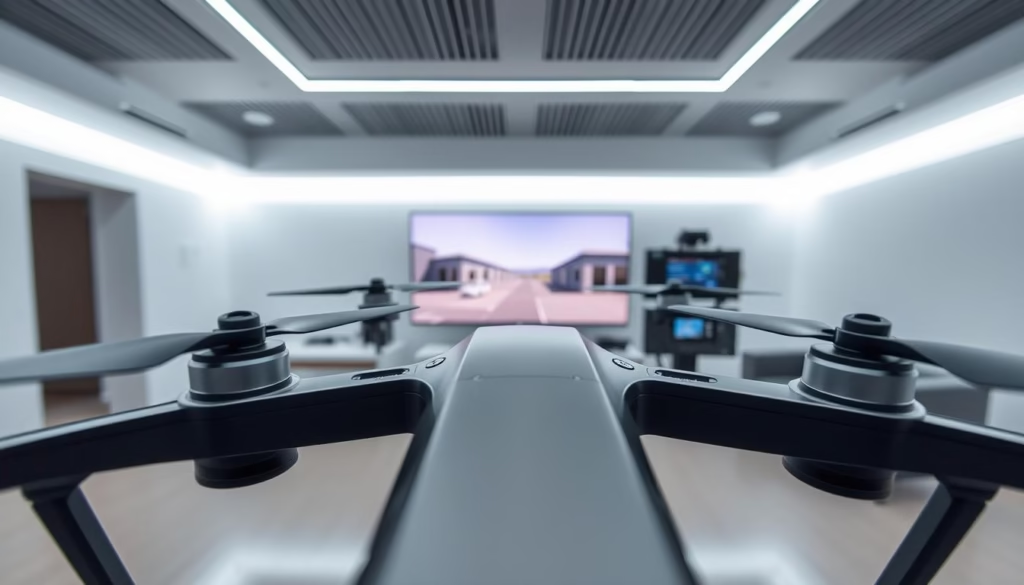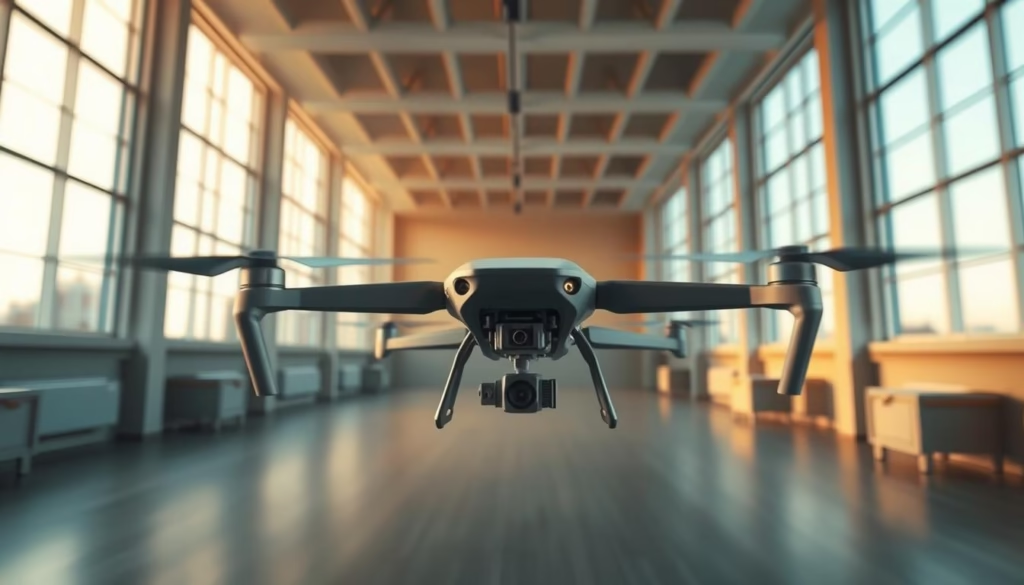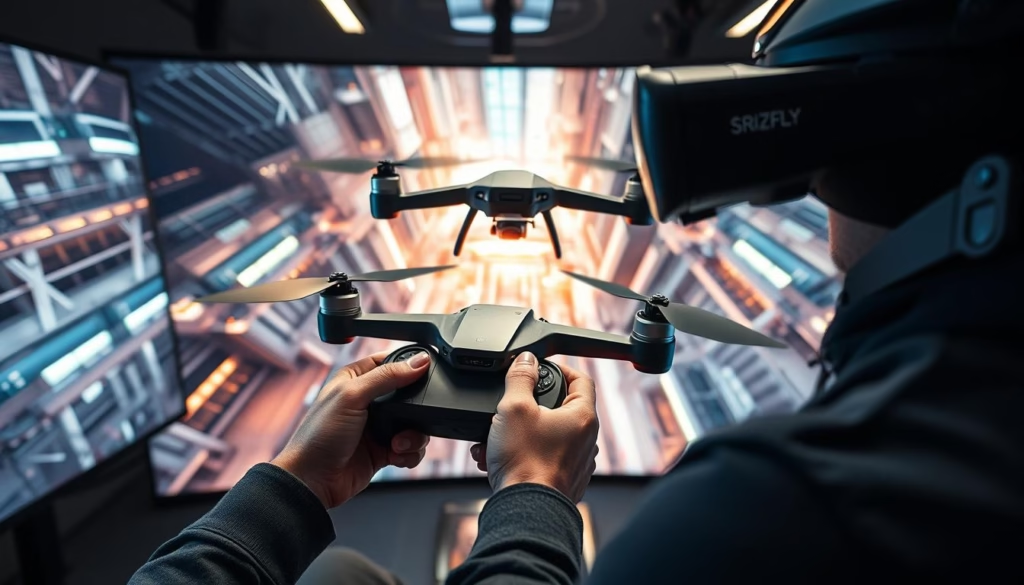Have you ever wondered how aspiring drone pilots refine their skills without ever taking to the skies? The answer lies in the best FPV drone simulator for PC. In this comprehensive review, we explore top drone simulations for computer, offering realistic environments that simulate real-life flying conditions. Choosing the right simulator can significantly impact your performance and confidence as a pilot. Our evaluations of the ultimate FPV drone training software focus on functionality, graphics, and user experience, providing you with the insights needed to find the ideal virtual flying companion.
Key Takeaways
- FPV drone simulators provide crucial practice before real flights.
- Graphics and realism vary, impacting user experience.
- Functionality features can significantly enhance training outcomes.
- A comprehensive review helps in choosing the right simulator for your needs.
- Understanding the differences between simulators can accelerate skill development.
- Investing in a quality simulator can save time and resources in real-world training.
What is an FPV Drone Simulator?
An FPV drone simulator serves as a virtual tool that allows users to experience flying drones from a first-person perspective. Understanding FPV drones involves recognizing their unique capability to provide an immersive flying experience, where operators can see in real-time as if they were onboard. These simulators replicate that experience, enabling novice and experienced pilots alike to practice without the risks associated with real-world flights.
Understanding FPV (First Person View) Drones
FPV drones utilize cameras mounted on the aircraft to transmit live video feeds back to the pilot. This technology transforms the flying experience, giving users a real-time view of the environment from above. Understanding FPV drones can enhance a pilot’s proficiency, making flight maneuvers more intuitive and exciting.
Benefits of Using a Simulator
The benefits of drone simulators are numerous. By using an FPV drone simulator, users can—
- Practice complex maneuvers in a safe environment.
- Gain confidence while navigating through various obstacles.
- Become familiar with drone controls before actual flights.
- Shorten the learning curve, making the transition to real flights smoother.
Incorporating a simulator into your training not only enhances skills but also reduces potential hazards associated with early-stage piloting. Experience the advantages of learning through simulation today.
Why Use a Drone Simulator?
Investing time in a drone simulator offers multiple advantages for both novice and experienced pilots. These tools serve as a crucial platform for enhancing flying skills while ensuring safety during the learning process.
Skill Development and Safety
Drone simulators significantly contribute to skill development by allowing pilots to hone their flying techniques without the risks associated with real-world flying. Users can practice maneuvers, manage emergency scenarios, and develop obstacle avoidance skills in a controlled environment. This approach not only promotes safety but also builds confidence before handling actual drones.
Cost-Effective Learning Tool
Many enthusiasts look for cost-effective drone training solutions. Utilizing a simulator eliminates costs incurred from physical drone repairs or replacements often caused by accidents during practice flights. Users gain valuable experience while minimizing financial risk. Various training programs can be accessed without breaking the bank, which makes learning to fly drones accessible to a broader audience.
Realistic Flight Experience
Drone simulators provide a realistic flight experience that mirrors the conditions pilots will face in the air. These platforms integrate advanced graphics and physics, replicating real-world dynamics faithfully. Whether navigating different landscapes or adjusting to varying weather conditions, simulators prepare users for the challenges of actual flying. Pilots who engage with these tools emerge better equipped for success when they take to the skies.
Overview of Popular FPV Drone Simulators
As the popularity of drone flying continues to rise, a variety of FPV drone simulators have become essential tools for aspiring pilots. These simulators provide unique opportunities for users to hone their skills in a controlled environment. Leading drone brands have introduced platforms that cater to different levels of experience, ensuring every user finds something that meets their training needs.
Comparing Features and Capabilities
When exploring popular FPV drone simulators, a simulators features comparison can help identify which product aligns best with your goals. Factors such as physics realism, visual quality, and customizable settings play a vital role. The following table highlights key aspects of some top simulators:
| Simulator | Realistic Physics | Adaptive Difficulty | Customization Options |
|---|---|---|---|
| Liftoff | Yes | Yes | High |
| DRL Simulator | Yes | No | Moderate |
| VelociDrone | Yes | Yes | Extensive |
Acknowledged Brands in the Market
Leading drone brands have solidified their presence in the FPV simulator market, making them popular FPV drone simulators among users. These brands stand out due to their commitment to creating immersive experiences. Liftoff, DRL Simulator, and VelociDrone have become notable names known for their exceptional performance and community engagement. By choosing a reputable simulator, users can leverage the expertise offered by these leading brands, enhancing their training and overall flying proficiency.
SRIZFLY: The DJI-Recognized Simulator
SRIZFLY stands out as a shared favorite among drone enthusiasts and professionals. As the only simulator brand recognized by DJI, it embodies high standards of quality and credibility within the drone training realm. This distinction not only highlights SRIZFLY’s commitment to excellence but also sets a benchmark for others in the industry.
What Sets SRIZFLY Apart?
The features of SRIZFLY contribute to its reputation as a leading choice in the market. Key aspects include:
- Exceptional Realism: The simulator closely mimics real-life flight conditions, enhancing pilots’ training experiences.
- Advanced Graphics: High-quality visuals make navigation intuitive while boosting the overall training experience.
- Authentic Control Mechanisms: The control systems in SRIZFLY allow for an accurate representation of actual drone handling.
User Experience and Feedback
Feedback from users consistently praises SRIZFLY for fostering an interactive community. Pilots can share invaluable insights, participate in contests, and exchange experiences, enriching their journey. Tailored training environments suitable for varying skill levels ensure that both beginners and seasoned professionals can benefit from the simulator. The emphasis on community and inclusive learning underscores SRIZFLY’s role in advancing drone training feedback.
Other Leading FPV Drone Simulators
Exploring alternative FPV drone simulators reveals a variety of options tailored to different flying styles and preferences. Each simulator offers unique features that can optimize your training experience, allowing you to enhance specific skills and immerse yourself in realistic flight scenarios.
Liftoff
The Liftoff simulator stands out due to its user-friendly setup and engaging multiplayer capabilities. It enables users to practice with friends or compete in exhilarating virtual races. The intuitive interface caters to novices while providing depth for advanced users, making it suitable for anyone seeking to improve their FPV skills.
DRL Simulator
The DRL flight simulator is designed specifically for high-speed racing enthusiasts. It accurately simulates the adrenaline-pumping experience of drone racing. Users can practice on virtual tracks modeled after actual racing events, enhancing their skills in a competitive environment. This simulator’s focus on speed and precision makes it a perfect choice for those wanting to excel in racing scenarios.
VelociDrone
VelociDrone features a strong emphasis on physics and realism, allowing for an incredibly authentic flying experience. Users can customize various settings to tailor their training according to personal preferences and skill levels. This flexibility makes it a favorite among seasoned pilots aiming to refine specific maneuvers and techniques.
| Simulator | Key Features | Ideal For |
|---|---|---|
| Liftoff | Multiplayer options, user-friendly setup | Beginners and casual flyers |
| DRL Simulator | High-speed racing simulation | Competitive racers |
| VelociDrone | Customizable settings, accurate physics | Experienced pilots focusing on specific skills |
Key Features to Look For
When evaluating a drone simulator, several essential features should be prioritized to ensure an effective learning experience. Understanding these drone simulator key features enhances users’ engagement and ultimately accelerates their training progress.
Realism and Graphics Quality
The graphics quality is crucial in creating an immersive environment. High-quality graphics provide realistic visuals that mimic real-world flight conditions. This realism aids in skill acquisition, allowing pilots to gain confidence when piloting actual drones. Advanced simulators offer physics-based models that accurately replicate drone behavior during various flight scenarios.
Customization Options
Customization features significantly enhance user experience. Users can adjust control sensitivity, environmental settings, and drone specifications according to their preferences. This flexibility supports different learning styles and skill levels. Tailoring settings promotes a more personalized training routine, ensuring that challenges are aligned with individual goals.
Multiplayer and Community Features
Strong community engagement in simulators fosters collaboration among users. Engaging with fellow enthusiasts through multiplayer modes allows learners to share tips and compete in challenges, enhancing motivation. A vibrant community provides valuable resources, from tutorials to feedback, that can accelerate the learning journey while building lasting connections among drone pilots.

System Requirements for FPV Drone Simulators
Understanding the system requirements for FPV drone simulators is vital for a seamless experience. These requirements can differ based on the graphical fidelity and features offered by each simulator. Knowing both the minimum specifications and recommended configurations can significantly enhance your training outcome.
Minimum vs. Recommended Specs
It is essential to distinguish between minimum specifications and recommended setups when considering an FPV simulator. The minimum specifications outline the basic hardware needed for the software to run. Recommended specs, on the other hand, ensure optimal performance, allowing users to fully enjoy advanced features and enhanced graphics. Below is a comparison table of common minimum and recommended specifications:
| Component | Minimum Specifications | Recommended Specifications |
|---|---|---|
| Processor | Intel i3 or equivalent | Intel i5 or better |
| RAM | 8 GB | 16 GB or more |
| Graphics Card | NVIDIA GTX 660 / AMD Radeon HD 7850 | NVIDIA GTX 1060 / AMD RX 580 |
| Storage | At least 5 GB free space | SSD with 10 GB free space |
Compatibility with Different Operating Systems
Compatibility with operating systems is another critical factor when selecting an FPV simulator. Most popular simulators support *Windows* and *macOS*, providing flexibility for users with different devices. Some simulators may offer additional support for Linux systems, broadening access for enthusiasts and professionals alike. Always verify the system requirements before installation to ensure a hassle-free experience.
Pricing of FPV Drone Simulators
Understanding the pricing of FPV drone simulators is essential for anyone interested in enhancing their piloting skills. The market offers a diverse range of options, from those that are free to those that require a financial investment. Assessing both free options and paid simulator value helps users make informed choices that align with their training needs.
Free vs. Paid Options
When exploring FPV drone simulators, free options often provide a basic learning experience, making them suitable for newcomers to the hobby. These simulators typically include essential features, allowing users to get a feel for flying without any financial commitment. In contrast, paid simulators deliver advanced functionalities, high-quality graphics, and often personalized support, making the investment worthwhile for serious users.
Value for Money: What to Expect
The pricing of FPV drone simulators can vary widely. It is crucial to evaluate what you receive for your money. Factors to consider include:
- Feature Set: Advanced paid options include enhanced physics, more drone models, and training exercises.
- Updates: Paid simulators typically offer regular updates, ensuring access to the latest features and improvements.
- Community Support: Some simulators have active communities that provide additional resources and troubleshooting assistance.
| Simulator Type | Price Range | Key Features | Community Support |
|---|---|---|---|
| Free Options | Free | Basic flight controls, limited models | Forums and basic guides |
| Paid Simulators | $15 – $99 | Advanced physics, multiplayer modes, various aircraft | Active community, direct support |
Tips for Getting the Most Out of Your Simulator
Maximizing your drone simulator experience requires a well-structured approach. Establishing clear practice routines allows for gradual skill development, especially in the early stages of training. Beginners should focus on foundational elements, while intermediate and advanced users can delve into more complex scenarios to enhance their proficiency. Tailoring these practice routines to specific personal goals will ensure effective use of the simulator, and enhance a range of flying techniques.
Practice Routines for Beginners
For those new to drone flying, implementing practice routines is crucial. Start with simple tasks such as:
- Understanding the simulator interface
- Executing basic maneuvers
- Testing flight controls through mock flights
- Transitioning between different flight modes
This approach builds confidence and a foundation for further skill development, resulting in a positive learning experience.
Advanced Techniques and Scenarios
Once comfortable with basic operations, advanced users can significantly benefit from integrating complex flight scenarios into their training. Focus on:
- Competitive racing courses to improve speed and precision
- Obstacle navigation that simulates real-life challenges
- Piloting in adverse weather conditions to enhance adaptability
- Multi-drone management for increased coordination skills
Incorporating these advanced flying techniques into your practice routines will elevate competence and prepare you for real-world flying challenges.

Conclusion: Choosing Your Best FPV Drone Simulator
In concluding our exploration of FPV drone simulators, we recognize that choosing the right FPV drone simulator is paramount to enhancing your flying skills and achieving your objectives. The reviewed options, particularly SRIZFLY, Liftoff, DRL Simulator, and VelociDrone, provide unique advantages that cater to different preferences and levels of experience. Your final recommendations should take into account features that align with your goals and the learning curve you wish to tackle.
As we look towards the future, trends in drone simulation are poised to shape user experiences significantly. Innovations in realism, training capabilities, and community connections are on the horizon, ensuring that simulators evolve alongside the rapidly advancing drone technology. By staying informed about these developments, you will better position yourself to select a simulator that not only meets your current needs but also anticipates future enhancements.
Ultimately, investing in a robust simulator is crucial for mastering the art of drone flying. By carefully considering your options, you can ensure that your choice today enables your growth as a skilled operator and keeps you at the forefront of the evolving landscape of FPV drone technology.
FAQ
What is the best FPV drone simulator for PC?
The best FPV drone simulator for PC often depends on individual preferences, but we recommend considering options like SRIZFLY for its realistic training features, Liftoff for its engaging multiplayer environment, and DRL Simulator for high-speed racing simulations.
How can a drone simulator improve my flying skills?
Utilizing a top drone simulation for computer allows you to practice complex maneuvers in a risk-free environment. You can develop skills like obstacle navigation and emergency responses, which significantly shortens the learning curve before flying a real drone.
Can I use a drone simulator on my laptop?
Yes, many leading FPV drone simulators for gaming PC are also compatible with laptops, as long as the specifications meet the minimum requirements. Options like SRIZFLY offer a great user experience on various systems.
What features should I look for in a top-rated PC drone simulator?
When seeking the best virtual drone flying experience, look for high-quality realism and graphics, customization options for training scenarios, and multiplayer features that enable interaction with other users.
Are there free drone simulator download options for PC?
Yes, several free options are available, but they typically offer limited features. For comprehensive functionality and support, opting for a paid simulator like VelociDrone or DRL Simulator is advisable.
What are the system requirements for the highest-rated drone simulator for Windows?
System requirements vary by simulator, but generally, you will need a good processor, updated graphics card, and sufficient RAM. Always check the specific requirements for each simulator to ensure smooth operation.
How do community features enhance my experience in a drone simulator?
Community features allow users to engage with fellow drone enthusiasts, share tips, participate in contests, and learn from others’ experiences, effectively enriching the learning environment and enhancing overall skill development.
What is the value of paid FPV drone simulators compared to free options?
Paid simulators typically offer advanced features, better graphics quality, and more personalized support compared to free simulators. Assess the overall value based on the specific features and updates provided to determine the best option for your training needs.
How can I maximize the effectiveness of my drone simulator practice?
Establishing structured practice routines is crucial. For beginners, focus on foundational skills, while advanced users should tackle complex scenarios that mimic real-world challenges, ensuring a comprehensive learning experience.




One Response